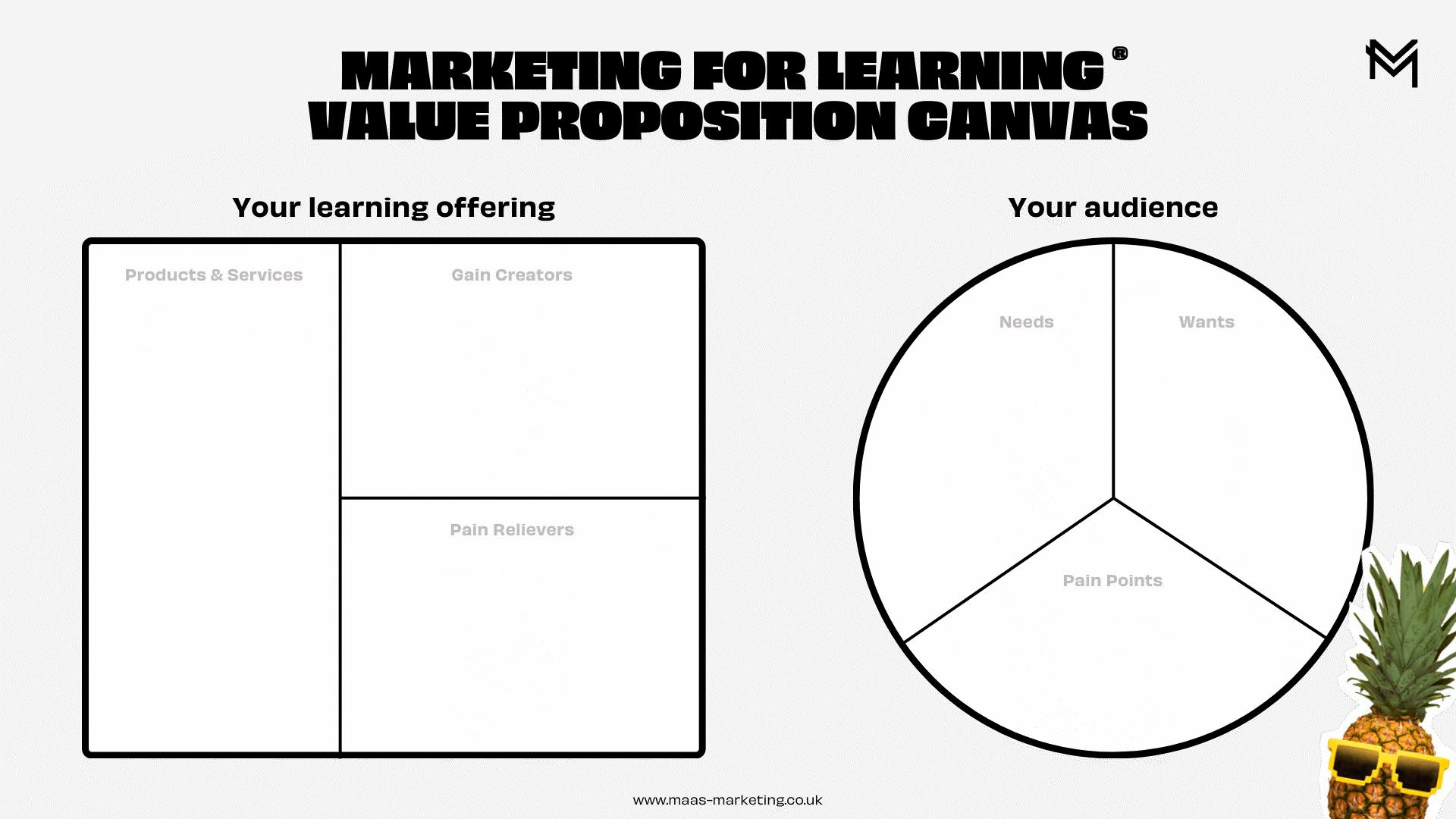want some cookies?
We use cookies to make your browsing experience amazing.

Using the Value Proposition Canvas in L&D has the potential to change the game for learning professionals. It helps teams to identify their learning product, understand their audience better, and perhaps most importantly, identify marketing opportunities for your learning function.
WHY SHOULD YOU USE THE VALUE PROPOSITION CANVAS IN L&D?
When asked the question “What’s your L&D product?” a lot of learning practitioners are left scratching their heads. “I dunno… learning?! The LMS? Elearning?!” *sigh*
If you want to effectively market your learning offering, you have to have a clear understanding of what your product is. And we have a nifty tool to help you get there. Enter: The Value Proposition Canvas (VPC). You may have seen, or heard of, the VPC before now. Because it is a business/marketing tool that we've adapted for the world of L&D – but you know us, we only share tools that *actually* work!
Defining your L&D product is about marrying up your offering to your target audience’s wants and needs – and highlighting how it’ll help them alleviate some of their fears and pain points. Simple right?
Well using the value proposition canvas in L&D makes it even more simple. By presenting your product’s features, benefits and experience, alongside your audience’s wants, needs and fears. Like so:

And once completed, the VPC enables you to craft more impactful marketing messages that relate to both the benefits of your product AND your audiences desires. Hey, it might even help you refine your product or realise a gap in your offering. 😲
So let’s look at how to use the value proposition canvas in L&D:
YOUR LEARNING PRODUCT
PRODUCT & SERVICES
Although you should never market your L&D product based on its features, you must understand them. Because our product features help us to determine the benefits of getting involved. But when you’re filling out your ‘Products & Services’ box, make sure you’re considering your entire learning offering. It’s really easy to just think of your LMS or LXP here. But what about your face-to-face programmes? Training days? PDFs? Learning in the flow of work? Make sure you include features of your entire offering!
GAIN CREATORS
What is it about your product that is going to positively impact somebody? How is it going to help them achieve their goals? Is it going to make them more productive? Is it going to help them climb the career ladder? Does it save them time? Does it equip them to prioritise themselves? Gain creators add the human element to your offering, and highlight what it is about your offering that offers your audience something new, or improves their existing process.
Looking at an example away from the world of learning, a feature of Apple devices is that they sync up with one another (i.e. your MacBook links with your iPhone and iPad). That’s a feature. The ‘gain’ of this is that you have seamless access to your photos, your contacts, your notes, and anything else that's on your iCloud account, no matter which device you have with you. #Simples
PAIN RELIEVERS
This box flips your ‘gain creators’ on their head, and instead of targeting the benefits of your product, we think about the ways it can alleviate your audience’s pain points. For example, is your learning offer inclusive, meaning everybody can get involved? Is it the best quality curated content meaning your audience doesn't have to search for themselves? Is it bite-sized so people don’t have to leave their day job for a full day? Ultimately here, we're looking at ways that we can bat away any naysayers when it comes to our learning offering.
Oftentimes the experience you anticipate your audience will have, and the reality of the experience, are vastly different. So we’d recommend talking to people about their lived experiences to help you fill out this box.
YOUR AUDIENCE
If you’ve created learner personas, then this side of your value proposition canvas will be a doddle. (And if you haven’t created personas, please do!)
On this side of your VPC you want to highlight your audience’s wants, needs and fears. This section will highlight the behavioural drivers for getting involved with your learning offering (or not) – and will massively help with your marketing initiatives. So let’s look at each section in a bit more detail:
WANTS
Forget about your learning offering for a second. In fact, forget about learning altogether. What is it your audience wants? What gets them out of bed in the morning? What is their ultimate aspiration?
The chances are, this has nothing to do with learning. They don’t want elearning, mobile learning or bite sized learning. What they want is development opportunities, career growth, more money! Sit down and think about your audience as humans – not learners! – and think about what they really want from life (and work!)
NEEDS
Unlike wants, needs are non-negotiable. So, where your audience might want ‘more money’, it’s likely that they need a stable income, for example. So step back and think about the non-negotiables for your audience. Might they need psychological safety? Time? Permission? There’s a lot that your audience might need before they can interact with your offering – and you must do the work to understand these!
FEARS & PAIN POINTS
If you’re like any of the L&Ders I’ve worked with, the chances are you won’t like filling out this box. We don’t like thinking about what other people fear, do we? Or the things that are causing them pain. It’s much easier to assume everything is sunshine and flowers. But however tempting it is to put on the rose tinted glasses; it’s really important to understand the fears and pain points your audience are facing.
This box unlocks a plethora of both marketing and product opportunities for you as an L&D team. For example, the fears and pain points box might highlight gaps in your offering that you can work to fill. Or, you might use this box to create an emotive marketing campaign. Although we’d never want to encourage a fear-based campaign, triggering some negative emotions might work well. For example: the growing skills gap. Marketing around this would be a fear-based message (don’t get left behind!) but it doesn't mean that you're trying to terrify everybody with your comms.
Using the value proposition canvas in L&D will help you zoom out and look at your entire learning offering. Somewhere between the two halves of your VPC lies marketing magic, the messages that will get your audience involved with your offering, the secret sauce that will help you make your learning irresistible. And once you’ve completed the VPC, it’s time to put it into action – now is the time to think about your marketing for learning strategy and learning campaigns! Because there’s no point doing all this work, and doing nothing with it – is there?! 😉 Happy marketing folks 🍍









